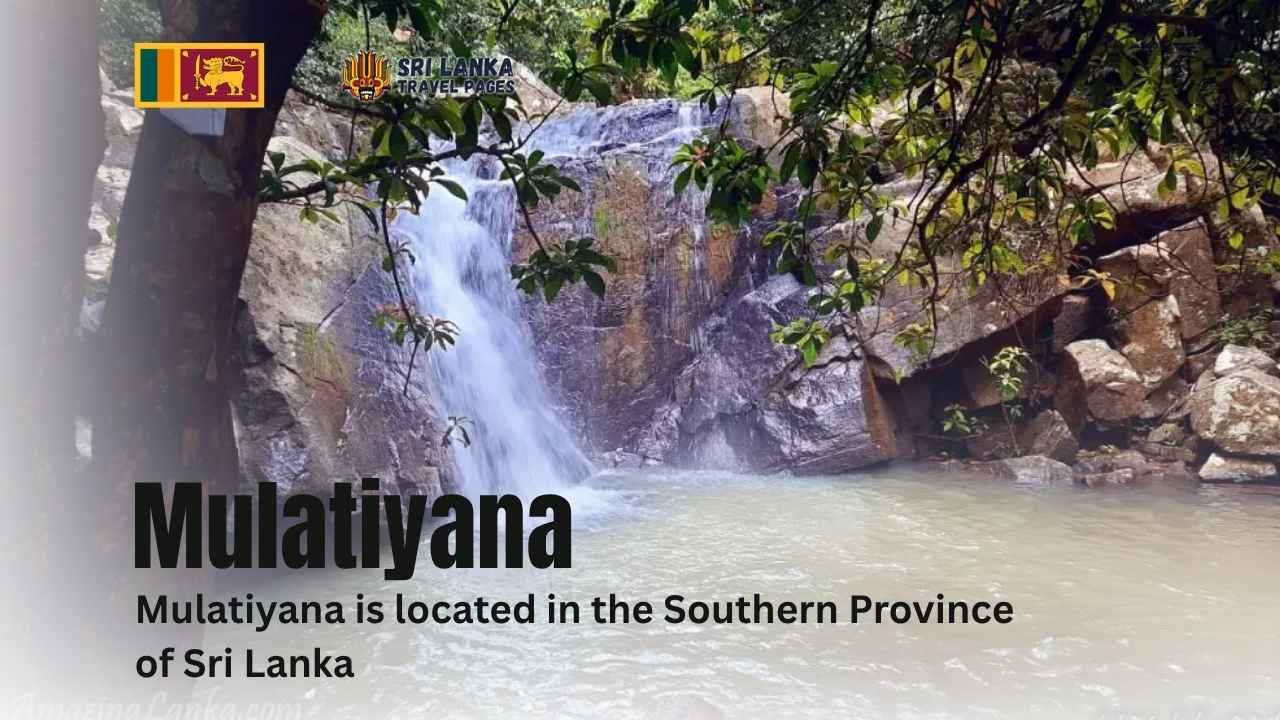
穆拉蒂亚纳, 穆拉蒂亚纳位于斯里兰卡南部省份马特勒区,是一个风景如画的内陆地区,以其葱郁的景色、丰富的农业资源和宁静的乡村氛围而闻名。这里被连绵起伏的丘陵、茶园、肉桂种植园和稻田环绕,为人们提供了一个远离喧嚣沿海城镇的清爽去处。当地经济以农业为主,茶叶、肉桂、胡椒和椰子种植是当地居民的支柱产业。这里的村庄保持着紧密的社区精神,丰富的文化传统以及在佛教寺庙和社区中心举办的宗教活动更是锦上添花。该地区遍布着自然景点,包括风景优美的观景点、河流和小瀑布,展现着其原始的自然之美。游客可以体验原汁原味的斯里兰卡乡村生活,探索香料园,或纯粹地享受乡村的宁静魅力。肥沃的土地、丰富的文化遗产和美丽的自然风光,使穆拉蒂亚纳成为南部省份中心地带一颗鲜为人知的瑰宝。
总人口
50,261
GN 部门
48
穆拉蒂亚纳:郁郁葱葱的山丘和宁静的乡村生活
斯里兰卡南部省份的一颗隐藏宝石
穆拉蒂亚纳坐落在斯里兰卡南部省份连绵起伏的丘陵之中,是一个迷人的乡村地区,以其肥沃的土地、清新的气候和宁静的环境而闻名。穆拉蒂亚纳位于马特勒内陆,是一处远离沿海喧嚣的风景胜地,将丰富的农业传统与地道的斯里兰卡乡村文化融为一体。这里绿意盎然的景观、茶园和香料园,使其成为热爱自然和寻求宁静的人们的天堂。
通往自然和乡村文化的大门
穆拉蒂亚纳的魅力在于其自然美景与当地文化遗产的和谐融合。游客可以探索香料园、茶园和郁郁葱葱的稻田,或享受乡村集市的宁静魅力。佛教寺庙和小型神社等宗教地标,体现了当地社区深厚的精神根基。
农业、经济和社区生活
农业是穆拉蒂亚纳的经济支柱,茶叶、肉桂、胡椒和椰子种植是当地居民的生计支柱。村庄的繁荣源于合作精神,农业、手工艺和小规模贸易丰富着当地居民的日常生活。季节性节日和寺庙庆典将社区凝聚在一起,展现着充满活力的文化。
自然、探险和节庆
穆拉蒂亚纳拥有自然小径、隐秘的瀑布和全景观景点,非常适合探索。传统的丰收节和宗教活动营造出热闹的氛围,而该地区原始的自然风光则为摄影和户外活动提供了无限可能。
教育、服务和地方行政
该地区设有多所公立学校、职业培训中心以及支持教育和技能发展的社区项目。当地拥有基础医疗设施,而附近的马塔拉则提供先进的医疗服务。穆拉蒂亚纳当地政府负责监督农村发展、道路网络以及维持社区生计的农业项目。
抵达穆拉蒂亚纳——交通和交通
🚖 乘坐出租车/私家车
从马特勒出发,沿风景秀丽的乡村道路行驶约 40-50 分钟即可到达穆拉蒂亚纳。
🚌 坐巴士
有定期巴士从马塔拉和附近的城镇开往穆拉蒂亚纳,连接沿途较小的村庄。
🚜 乘坐当地交通工具
三轮车和摩托车是村庄和农田之间短途旅行的常见交通工具。
无论您是寻求宁静的休憩之所、真实的乡村体验,还是穿越斯里兰卡农业中心地带的旅程,穆拉蒂亚纳 (Mulatiyana) 都会为您提供热情的欢迎,让您一睹宁静的乡村生活节奏。
| 服务 | 联系电话 | 附加信息 |
|---|---|---|
| 🚓 穆拉蒂亚纳警察局 | +94 41 227 7255 | 当地执法办公室负责确保穆拉蒂亚纳及周边村庄的公共安全、预防犯罪和社区警务。 |
| 🏥 分区医院 – Mulatiyana | +94 41 227 7250 | 政府医院为当地社区提供门诊服务、基本住院护理、产科和紧急治疗。 |
| 🏥 初级医疗保健单位 | 因地点而异 | 小型公共卫生中心为穆拉蒂亚纳的农村提供门诊咨询、基本医疗和急救服务。 |
| 🏛️ 穆拉蒂亚纳分区秘书处 | +94 41 227 7201 | 负责穆拉蒂亚纳省的当地行政、发展项目、民事登记和公共服务。 |
| 🧾 卫生部办公室 – 穆拉蒂亚纳 | +94 41 227 7252 | 协调公共卫生计划、疾病预防运动、妇幼保健和社区健康意识。 |
| GN代码 | 姓名 |
|---|---|
| 005 | 贡巴达拉北 |
| 010 | 库达帕纳 |
| 015 | 凯塔帕拉坎达 |
| 020 | 加姆梅达加马 |
| 025 | 凯蒂亚佩北部 |
| 030 | 阿塔帕图坎达 |
| 035 | 帕拉帕穆拉东 |
| 040 | 南凯蒂亚佩 |
| 045 | 加莱通巴 |
| 050 | 内拉兰皮蒂亚 |
| 055 | 穆拉蒂亚纳 |
| 060 | 北迪德尼波塔 |
| 065 | 贝拉加马北部 |
| 070 | 贡巴达拉南 |
| 075 | 贝拉加马西 |
| 080 | 贝拉加马南 |
| 085 | 马坎杜拉西 |
| 090 | 贝拉加马东 |
| 095 | 迪德尼波塔东部 |
| 100 | 南迪德尼波塔 |
| 105 | 西尼佩拉·韦斯特 |
| 110 | 马杜瓦拉 |
| 115 | 西尼佩拉东 |
| 120 | 德扬达拉 |
| 125 | 帕拉帕穆拉西部 |
| 130 | 帕拉帕穆拉南部 |
| 135 | 德瓦勒加马西 |
| 140 | 德瓦勒加马东 |
| 145 | 巴塔多拉 |
| 150 | 基斯西里普拉 |
| 155 | 拉达维拉·韦斯特 |
| 160 | 贝尔帕穆拉 |
| 165 | 巴穆努加马西 |
| 170 | 马坎杜拉东部 |
| 175 | 兰斯戈达东 |
| 180 | 米帕维塔 |
| 185 | 穆达利格达拉 |
| 190 | 拉特克库拉瓦 |
| 195 | 兰塞戈达北部 |
| 200 | 南兰塞戈达 |
| 205 | 兰斯戈达西 |
| 210 | 科兰布鲁瓦纳 |
| 215 | 霍拉帕维塔南 |
| 220 | 霍拉帕维塔北部 |
| 225 | 巴穆努加马东 |
| 230 | 拉达维拉东 |
| 235 | 帕拉维拉 |
| 240 | 皮塔瓦尔加穆瓦 |
游览穆拉蒂亚纳的最佳时间
游览穆拉蒂亚纳的最佳时间是一月至四月,以及七月至九月。此时气候干燥,阳光明媚,非常适合户外探险。这两个月份气温适宜,非常适合观光、自然漫步和游览当地景点,且不会受到大雨的干扰。
五月至六月和十月至十二月,受季风影响,该地区降雨更频繁。虽然这些时期植被茂盛,气候凉爽,但户外计划偶尔会被阵雨打断。然而,这仍然是一个宁静的时节,可以尽情享受穆拉蒂亚纳的乡村魅力,远离喧嚣的游客。
总的来说,在干燥的月份计划您的旅行可以确保您充分体验穆拉蒂亚纳的农业景观、文化遗址和宁静的乡村生活的最佳状态。
如何到达 – Mulatiyana
穆拉蒂亚纳位于斯里兰卡南部省份马特勒区,是一个风景秀丽的内陆地区,以其乡村魅力、郁郁葱葱的茶园和宁静的环境而闻名。它位于马特勒镇东北部,可通过马特勒、加勒和科伦坡等主要城市便捷的公路网络抵达。无论您是乘坐汽车、巴士还是摩托车,都能欣赏到迷人的乡村景色,并一睹斯里兰卡农业中心地带的风采。以下是一份旅行指南,可帮助您规划行程。
| 城市 | 距离 | 预计行程时间 | 路线 |
|---|---|---|---|
| 科伦坡堡 | 165公里 | 3.5 – 4 小时 | |
| 加勒 | 87公里 | 2 – 2.5 小时 | |
| 马塔拉 | 38公里 | 1 – 1.2 小时 | |
| 阿库雷莎 | 18公里 | 30 – 35分钟 | |
| 德尼亚亚 | 25公里 | 45 – 55分钟 |
交互式地图
地理概况 – Mulatiyana
穆拉蒂亚纳是斯里兰卡南部省马特勒区一个宁静的内陆省份,周围绿树成荫,丘陵起伏,农田肥沃。穆拉蒂亚纳远离繁忙的沿海地带,拥有宁静的乡村环境,茶叶、肉桂、椰子和水稻种植业蓬勃发展。该地区散布着小村庄、风景秀丽的溪流和茂密的森林,反映了斯里兰卡南部乡村的传统生活方式。穆拉蒂亚纳以其凉爽清新的气候和自然美景而闻名,也是通往附近自然景点和文化地标的门户。其乡村魅力将农业生产力与社区传统融为一体,使其成为寻求纯正斯里兰卡乡村体验的游客的独特目的地。
行政信息
- 省: 南部省
- 区: 马特勒区
- 部门秘书处: 穆拉蒂亚纳分区秘书处
- 邻近地区: Akuressa、Kotapola、Kamburupitiya、Pitabeddara
地方经济与服务 – Mulatiyana
穆拉蒂亚纳的经济主要以农业为主,茶叶、肉桂、椰子、胡椒和水稻种植构成了当地居民的生计支柱。小规模的蔬菜和水果种植也很普遍,既满足了家庭需求,也满足了区域市场的需求。许多居民在合作社和农民组织的支持下,从事着世代相传的传统农业实践。风景优美的环境和肥沃的土壤使穆拉蒂亚纳成为马特勒地区重要的农业中心。
该地区由穆拉蒂亚纳分区医院等公共医疗机构以及规模较小的乡村卫生中心提供服务。教育由公立学校提供,包括小学和中学,以确保周边村庄的儿童获得教育机会。穆拉蒂亚纳分区秘书处负责管理行政服务、基础设施建设和地方福利项目,而乡村银行和小额信贷机构则支持社区的经济需求。
穆拉蒂亚纳可通过连接阿库雷萨、科塔波拉和马塔拉镇的区域公路网络抵达。当地公交车和三轮车提供定期交通,确保村庄与城镇中心之间的互联互通。该地区深厚的农业传统,加上社区合作和不断发展的基础设施,使穆拉蒂亚纳在传承传统的同时,不断改善农村生计。
社区与文化 – Mulatiyana
穆拉蒂亚纳是一个紧密团结的农村社区,斯里兰卡的传统价值观依然深深植根于其日常生活之中。大多数居民信奉僧伽罗佛教,基督教徒和其他宗教少数群体也构成了其社会结构的一部分。该地区的文化特征由其农业传统塑造,农民家庭经常聚集在一起进行季节性的种植和收获仪式,从而培养了居民之间强烈的团结与合作意识。
宗教和文化活动在社区生活中扮演着核心角色。卫塞节、波森节以及僧伽罗新年和泰米尔新年,都会通过寺庙仪式、游行和乡村节庆来庆祝。当地的佛教寺庙既是精神中心,也是社交中心,而教堂则会举办季节性的礼拜和聚会。这些活动将来自不同村庄的家庭聚集在一起,加强了社会联系,并传承了悠久的传统。
穆拉蒂亚纳的社区精神也体现在合作农业协会、青年俱乐部和妇女团体中,这些组织支持社会福利、教育和环保意识活动。尽管现代影响正在逐渐塑造日常生活的各个方面,但该地区的文化仍然牢牢扎根于其乡村根基,崇尚简朴、热情好客以及与土地的紧密联系。
节日与文化 – 穆拉蒂亚纳
穆拉蒂亚纳位于马特勒县郁郁葱葱的乡村中心地带,其庆典活动融合了丰富的传统、灵性和社区团结。当地居民主要信奉僧伽罗佛教,基督教社区也增添了文化多样性。主要节日包括: 卫塞节, 波森, 埃萨拉, 圣诞节,以及 僧伽罗和泰米尔新年 整个社区都会虔诚、喜悦地庆祝并积极参与。
期间 卫塞节 和 波森穆拉蒂亚纳的寺庙灯火辉煌,佛教艺术装饰精美。村民们组织 丹萨尔 为游客提供免费食物,象征着慷慨和同情。僧伽罗和泰米尔新年带来了传统游戏、击鼓和公共盛宴,而基督教教堂则举办特别的圣诞节和复活节礼拜,以促进不同信仰之间的和谐。
穆拉蒂亚纳的文化生活与其乡村传统紧密相连,丰收庆典、学校音乐会和庙会丰富了社会结构。这些活动加强了社区联系,传承了古老的习俗,并弘扬了构成穆拉蒂亚纳文化特征的团结精神。
交通和连通性 – Mulatiyana
穆拉蒂亚纳是马特勒区一个风景如画的内陆地区,主要通过公路与周边城镇交通便利。穆拉蒂亚纳位于马特勒东北约20公里处,可通过 马塔拉–德尼亚亚 (B363) 公路 并连接乡村路线。这使得居民和游客可以方便地乘坐私家车、摩托车和公共汽车出行,这些公共汽车定期往返于穆拉蒂亚纳和马塔拉、阿库雷萨和德尼亚亚等附近城镇之间。
穆拉蒂亚纳没有自己的火车站,但最近的火车站位于马特勒和韦利格默,提供前往科伦坡、加勒和南部省其他地区的火车服务。对于本地出行, 三轮车(嘟嘟车)、摩托车和小型客货车被广泛使用,确保了该地区灵活且经济的交通选择。
公共和私人巴士连接穆拉蒂亚纳和各区域枢纽,而马塔拉的城际巴士服务则延伸至斯里兰卡其他地区。穆拉蒂亚纳拥有便捷的公路交通和靠近大型交通枢纽的便利性,在乡村魅力与居民、商贩和游客的便捷性之间实现了完美平衡。
环境意义和可持续性——穆拉蒂亚纳
穆拉蒂亚纳位于马特勒区郁郁葱葱的内陆地区,以其丰富的生物多样性、肥沃的地貌和与农业的紧密联系而闻名。该地区周围环绕着稻田、橡胶种植园、茶园和香料种植园,这些不仅维持着当地居民的生计,也为斯里兰卡的农业经济做出了贡献。肥沃的山谷和森林为各种动植物提供了栖息地,提升了该地区的生态价值。
近年来,地方政府和社区团体大力推广可持续农业技术、有机种植和土壤保护措施,以保障农业生产力。小规模的重新造林项目和水资源保护项目旨在保护自然资源,为子孙后代守护环境。
在学校和农村社区开展的教育活动提高了人们对环境管理重要性的认识。通过将传统知识与现代可持续实践相结合,穆拉蒂亚纳不断巩固其作为负责任农业中心的地位,在发展与环境保护之间取得平衡。
旅游和景点 – Mulatiyana
穆拉蒂亚纳位于斯里兰卡南部省份马特勒区,是一个宁静的内陆地区,以其葱郁的绿地、肥沃的土地和深厚的农业遗产而闻名。穆拉蒂亚纳周围环绕着茶园、橡胶种植园和稻田,散发着宁静的乡村魅力,与南部繁华的沿海城镇形成鲜明对比。
该地区遍布风景秀丽的瀑布、河流和森林覆盖的山坡,是自然爱好者和生态游客的热门目的地。当地景点包括文化底蕴深厚的乡村寺庙、传统的香料园以及乡村步道,让游客体验地道的乡村生活。季节性节日和文化聚会为游客提供了体验悠久习俗和温暖社区精神的机会。
虽然穆拉蒂亚纳并非主流旅游中心,但它为寻求宁静、美景和一窥斯里兰卡农业中心地带的游客提供了令人耳目一新的非同寻常的体验。其自然魅力和热情好客的民风,使其成为探索沿海以外南部省份的游客的理想目的地。
教育与机构 – Mulatiyana
穆拉蒂亚纳以其丰富的农业资源和乡村魅力而闻名,非常重视社区的教育发展。学校包括 穆拉蒂亚纳中央学院 和 德亚达拉国立学校 作为中小学教育的重点机构,为该镇及周边村庄的学生提供学术和课外课程。
该地区由以下网络提供支持 公立学校 和 国立学校 提供涵盖科学、商业、艺术和技术等各领域的广泛课程。私人补习中心和职业培训机构面向希望接受高等教育或从事农业、商业和技术行业的学生。学校特别注重与当地经济相关的实践培训,包括农业技术和农业企业管理。
通过社区参与、学校主导的环保项目以及职业指导计划,穆拉蒂亚纳正在培养一代知识渊博、技能娴熟、富有社会责任感的年轻公民。这些努力确保教育继续成为该镇发展和可持续发展的驱动力。
医疗保健和医疗服务 – Mulatiyana
穆拉蒂亚纳提供必要的医疗设施,服务于其以农村为主的社区。主要的公共机构是 分区医院 – Mulatiyana提供门诊、急诊、妇产科和儿科以及普通医疗服务。医院配备了专业的医疗人员,满足全院居民的基本医疗需求。
这 卫生官(MOH)办公室 - 穆拉蒂亚纳 负责监督公共卫生项目,包括疫苗接种运动、妇幼保健、疾病预防和营养意识倡议。 基层医疗诊所, 药店, 和 传统阿育吠陀治疗中心 补充公共医疗保健,为社区提供现代和传统医疗选择。
对于专科治疗或高级医疗护理,居民可以前往马塔拉等附近城镇的大型医疗机构,包括 马塔拉综合医院。通过结合公共卫生服务、社区护理和传统治疗方法,穆拉蒂亚纳在满足农村人口独特需求的同时,继续支持人民的福祉。
穆拉蒂亚纳之旅推荐——自然、文化与乡村魅力
穆拉蒂亚纳坐落在斯里兰卡风景秀丽的南部省,是一个宁静的乡村天堂,以其郁郁葱葱的绿地、肥沃的农田和紧密团结的社区精神而闻名。与熙熙攘攘的沿海城镇不同,穆拉蒂亚纳为游客提供了一个静谧的休憩之所,让您沉浸在斯里兰卡的乡村生活之中。这里周围环绕着连绵起伏的丘陵、稻田以及茶园和肉桂种植园,展现着该地区的农业传统。
从探索宁静的寺庙、参加丰富多彩的乡村节庆,到欣赏乡村的自然美景,穆拉蒂亚纳诚邀游客体验地道的斯里兰卡文化。当地市场、传统的农耕习俗以及热情好客的民风,为寻求慢节奏生活的人们营造出温馨宜人的氛围。穆拉蒂亚纳拥有丰富的传统、自然的魅力以及真诚的社区温暖,是南部省一颗值得探索的隐秘瑰宝。
